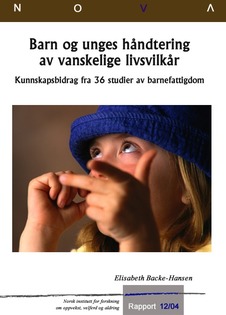| dc.contributor.author | Backe-Hansen, Elisabeth | |
| dc.date.accessioned | 2020-06-07T21:04:53Z | |
| dc.date.accessioned | 2021-04-29T13:52:39Z | |
| dc.date.available | 2020-06-07T21:04:53Z | |
| dc.date.available | 2021-04-29T13:52:39Z | |
| dc.date.issued | 2004 | |
| dc.identifier.isbn | 82-7894-193-9 | |
| dc.identifier.issn | 0808-5013 | |
| dc.identifier.uri | https://hdl.handle.net/20.500.12199/3190 | |
| dc.description.abstract | SummaryIn this report, contributions from 36 studies of how children and young people handle economic adversity and poverty are presented. The studies were published between 1989 and 2003. The point of departure is already existing knowledge about correlations between poverty and a series of problematic outcomes. In this report, is has been more important to analyze in what ways poverty matters, rather than the fact that poverty does matter. The results can be grouped in five conclusions. The first is that children and young people handle economic deprivation through becoming economic actors in a relational and social context. Such results are particularly evident in studies focusing on coping mechanisms. The second conclusion is the necessity of a dynamic understanding of child poverty, with five prerequisites. Precise measures of family income are needed, combining objective and subjective measures. Further, measures of movements into and out of poverty are needed, as are measures of the timing and duration of poverty episodes. Finally, research needs to incorporate variations in relevant mechanisms due to ethnicity. The third conclusion concerns the powerful mediators. The literature is in agreement that poverty and economic deprivation mainly influences child and adolescent outcomes in an indirect manner. The quality of care offered by the parents is seen as the most powerful mediator, with characteristics of the neighbourhood added where older children and youth are concerned. The fourth conclusion highlights the problematic outcome measures. It seems as if the theoretical and/or social policy point of departure of the researchers to a great extent influence the choice of outcome measures, and that the results are in accordance with these. On the other hand it is fairly rare to reflect on the choice of outcome measures. The fifth and final conclusion is about variations and patterns in positive and problematic developmental paths. Here, it becomes obvious that in a life course perspective, development depends on more than economic deprivation. Poverty must be understood as one among several risk factors jeopardizing children and young peoples well-being and development. The outcome will depend on the number of risk factors as well as the duration and intensity of the adversity that is experienced. On the other hand important, protective factors are close relationships to adults who combine care and monitoring in functional ways, that pro-social behaviour is learned and reinforced, and stimulating children and young peoples cognitive capabilities. The report ends with suggestions for further research and a discussion of services. | en |
| dc.description.abstract | Temaet for denne rapporten er barn og unges håndtering av vanskelige, materielle livsvilkår, basert på en gjennomgang av 36 studier. En oppvekst i fattigdom eller med økonomisk knapphet påvirker barn og unges utvikling, ikke bare deres hverdagsliv. Forskningen om dette finner en rekke uheldige virkninger, som atferdsproblemer, dårligere skoleprestasjoner, kortere utdanningsløp, tidligere graviditeter, problemer med å få og beholde arbeid og kriminalitet. Særlig knyttes slike virkninger til langvarig og alvorlig fattigdom, mens det å oppleve økonomisk knapphet i kortere perioder ikke behøver å få spesielt alvorlige konsekvenser. På den andre siden vil et godt forhold mellom foreldre og barn, der foreldrene kombinerer omsorg og oppfølging på en fornuftig måte, fungere som en buffer både mot virkningene av fattigdom og av å vokse opp i utsatte nabolag. Forløpsstudier der en ser på mekanismene bak både positive og uheldige utviklingsforløp får fram det dynamiske samspillet mellom risikofaktorer og beskyttende faktorer, som igjen fører til at noen barn og unge tåler negative påvirkninger bedre enn andre. Kunnskapsbidraget fra de 36 studiene gjør det også mulig å tenke nytt om forskningsbehov og tiltak tilpasset norske forhold, og forslag om både videre forskning og tiltak avslutter rapporten. | no_NB |
| dc.publisher | Oslo Metropolitan University - OsloMet: NOVA | |
| dc.relation.ispartofseries | NOVA Rapport 12/04 | |
| dc.subject | NOVA | |
| dc.title | Barn og unges håndtering av vanskelige livsvilkår | no_NB |
| dc.type | Research report | |
| fagarkivet.author.link | https://www.oslomet.no/om/ansatt/ebha | |
| fagarkivet.source.pagenumber | 274 | |
